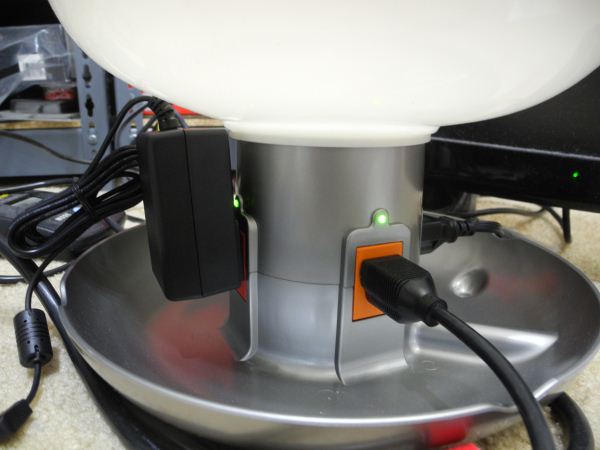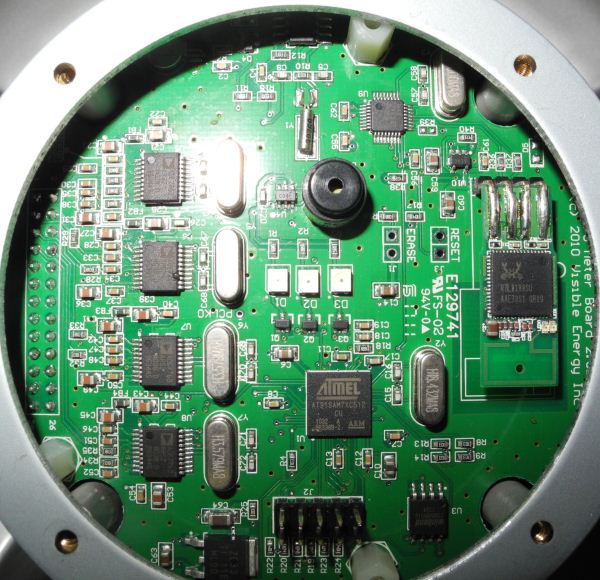Visible Energy UFO Power Center Smart Power Strip Review
by Ganesh T S on October 26, 2012 8:00 AM EST- Posted in
- Home Automation
- Wi-Fi
- Visible Energy
Hardware and Industrial Design
The industrial design of the UFO Power Center is definitely eye-catching, and may make for a good fit in some entertainment centers. Due to the non-standard design, it is sure to elicit polarizing opinions. Unfortunately, we are not great fans of the current size and shape of the unit. With a diameter of 12” and a height of 5”, it is too big to fit in most places where space is at a premium.
In addition, the clearance above and below the receptacles is not large enough for some ‘wall wart’ adapters, as shown in the photograph below (The adapter belongs to the Iomega EZ network attached hard disk). It is not possible to install the adapter with the output wire pointing downwards. Keeping the output wire pointed upwards (as shown below) makes it impossible to close the dome without dislodging the precariously positioned adapter from the receptacle.
Visible Energy has a blog post explaining the reason behind the size of the unit, and we will leave it to the reader to be the final judge.
Most of us are interested in the internals of the unit. Disassembling the unit exposed the following main components:
- 4x Schrack RT314F05 power relays, each of which is rated for 250V / 16A
- TI ULN2803A for switching the relay
- TNY278GN power switcher
- 4x ADE7763 energy metering ICs
- Atmel AT91SAM7XC512-CU microcontroller
- Realtek RTL8188SU 802.11b/g/n 1T1R WLAN Controller with USB 2.0 Interface
Despite being equipped with four relays capable of handling 16A each, Visible Energy has decided to play it safe by rating the whole unit for a maximum of 15A only.
A number of Wi-Fi companies (including TI, Qualcomm - Atheros and Marvell) have recently introduced a low cost system integrating the Wi-Fi radio and a MCU. Visible Energy currently uses two distinct chips for this, one from Atmel and the other from Realtek. The big vendors require complicated NDAs and large upfront payments. Given the projected low volume nature of the UFO Power Center (after all, it is Visible Energy’s first product) we actually need to applaud the company for choosing off-the-shelf components and making the entry price acceptable.
The Atmel microcontroller coordinates the operation of the unit as it sets up the ADE7763 chips for energy and power measurement. Power usage is computed and updated every second, while the energy usage is continuously monitored, but gets stored out once every five minutes. It also responds to the network requests from the Wi-Fi chip and sends back the requested data or modifies the relay status as applicable. The microcontroller also phones back home (to service.visiblenergy.com) with the energy / power data and socket status while also fetching any actions to be completed. These actions may have been set up by the user over the cloud interface. This pull mechanism enables control over the Internet without opening up any ports in the router for the unit. The downside is the fact that any change made to the socket status over the Internet could potentially take up to a minute to get reflected in the unit. Over the local network (for the iOS app / custom scripts using the open APIs), this is not a problem.
In addition, there are a number of other components such as a dedicated RTC (real time clock) and 1 MB of Flash memory for storage of energy history. This allows storage of the energy history of each socket for the previous 2 months at the minimum.
The LEDs and the Wi-Fi radio / miscellaneous board components contribute to a total power consumption of around 2.2 W even when nothing is connected to the sockets. By turning off the LEDs and the relays, it is possible to bring down the power to around 1.5 W.













35 Comments
View All Comments
OCedHrt - Friday, October 26, 2012 - link
It does look like it would fit then?ssddaydream - Friday, October 26, 2012 - link
I actually would enjoy having a device like this if it were in the common surge suppressor form factor. I think the lamp-like UFO appearance detracts from the product. I usually mount stuff like this behind the desk where it is still accessible, but out of view. I'm sure I could find a way to get this thing mounted and tucked away, but it takes up valuable extra space needlessly.ZETAPIERRE - Friday, October 26, 2012 - link
We have one made that is WiFi. It has only a duplex receptacle, but each half is individually controlled. It too uses 16A relays, the same type. We use them to collect power information and to control equipment at work. We power the compressors, printers, solderbench, etc... We also have a control in the system tray that allows employees to turn on the equipment. If they forget to turn it off, it goes off under a timer. It's software, so you can make it do anything, even send out emails.Flunk - Friday, October 26, 2012 - link
"There is no way to change the HTTP access port. This might be useful in the case where the user cooks up a custom script to control / query the unit, but wants to use it from an external network. It is possible to set up port forwarding to access the unit via the default HTTP port. However, in the case that this port already forwards to another machine in the local network, the user has no way to access the UFO over the Internet without modifying the HTTP port of the other machine."A lot of routers, even cheap ones, support routing with different external and internal ports. E.G. mapping port 3333 to port 80 on 192.168.1.1 so this isn't that big of a deal.
IKeelU - Friday, October 26, 2012 - link
So many of my power cables are longer than they need to be (for my needs), so setting up my home theater or adding a new component always involves some form of cable management to ensure I don't have spaghetti back there. This design, while a bit cumbersome, would alleviate that.nathanddrews - Friday, October 26, 2012 - link
This is odd for an eco-driven device. Why would I want to buy something that consumes that much power on its own (WiFi/bulb) in order to monitor and regulate power? Seems counterintuitive, but I suppose there are many people that don't have wired connections in their homes (sad). The option would be nice. The fact that it is completely fugly as a lamp is also confusing. That last bit is subjective, I realize...Looking foward to future revisions, though! I'd love to have a wired rackmount version for my server rack, my home theater, and then conventional looking power strips for other power-hungry areas (washer/dryer, office devices, other entertainment areas, powertools in workshop, etc.).
NeBlackCat - Friday, October 26, 2012 - link
+1 for rackmount versionAs an eco fascist I'd be tempted to have my house electrics rewired from the standard multiple "multidrop" circuits, to a single star configuration where every power outlet/device goes to a UFO port.
The things I could then do...
DanNeely - Friday, October 26, 2012 - link
The reason most outlets are wired in a multiloop fashion is to minimize copper use. Replacing an N outlet loop with N outlets wired in a star pattern will use approximately N times more copper.After being convicted by the court in eco Nuremberg for wasteful use of resources extracted by destructive mining you wouldn't be able to do much beyond pushing up daisies.
taltamir - Friday, October 26, 2012 - link
By law, businesses must be wired in a star configuration rather than multidrop.Multidrop is used because its cheaper, but its less safe as multiple outlets share a single line.
ironargonaut - Sunday, November 4, 2012 - link
In what country? I can overload a single 20A receptacle by creating a short just as easy as a 10 receptacles on the same loop. The only thing that matters is you keep the breaker small enough to trip before the wire insulation fails. I.E. don't use 14guage wire with a 20A breaker...etc.Technically all homes/businesses use a star config as you have multiple breakers, but you also have multiple lights/outlets per breaker. Or am I defining "star" config differently then you?